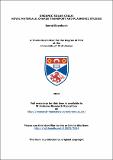Files in this item
Organic solar cells : Novel materials, charge transport and plasmonic studies
Item metadata
| dc.contributor.advisor | Samuel, Ifor D. W. | |
| dc.contributor.author | Ebenhoch, Bernd | |
| dc.coverage.spatial | xi, 177 p. | en_US |
| dc.date.accessioned | 2015-11-18T15:50:15Z | |
| dc.date.available | 2015-11-18T15:50:15Z | |
| dc.date.issued | 2015-11-30 | |
| dc.identifier.uri | https://hdl.handle.net/10023/7814 | |
| dc.description.abstract | Organic solar cells have great potential for cost-effective and large area electricity production, but their applicability is limited by the relatively low efficiency. In this dissertation I report investigations of novel materials and the underlying principles of organic solar cells, carried out at the University of St Andrews between 2011 and 2015. Key results of this investigation: • The charge carrier mobility of organic semiconductors in the active layer of polymer solar cells has a rather small influence on the power conversion efficiency. Cooling solar cells of the polymer:fullerene blend PTB7:PC₇₁BM from room temperature to 77 K decreased the hole mobility by a factor of thousand but the device efficiency only halved. • Subphthalocyanine molecules, which are commonly used as electron donor materials in vacuum-deposited active layers of organic solar cells, can, by a slight structural modification, also be used as efficient electron acceptor materials in solution-deposited active layers. Additionally these acceptors offer, compared to standard fullerene acceptors,advantages of a stronger light absorption at the peak of the solar spectrum. • A low band-gap polymer donor material requires a careful selection of the acceptor material in order to achieve efficient charge separation and a maximum open circuit voltage. • Metal structures in nanometer-size can efficiently enhance the electric field and light absorption in organic semiconductors by plasmonic resonance. The fluorescence of a P3HT polymer film above silver nanowires, separated by PEDOT:PSS, increased by factor of two. This could be clearly assigned to an enhanced absorption as the radiative transition of P3HT was identical beside the nanowires. • The use of a processing additive in the casting solution for the active layer of organic solar cells of PTB7:PC₇₁BM strongly influences the morphology, which leads not only to an optimum of charge separation but also to optimal charge collection. | en_US |
| dc.language.iso | en | en_US |
| dc.publisher | University of St Andrews | |
| dc.rights | Creative Commons Attribution 4.0 International | |
| dc.rights.uri | http://creativecommons.org/licenses/by/4.0/ | |
| dc.subject | Solution-processed solar cells | en_US |
| dc.subject | Low-band gap BBT-DPP polymer | en_US |
| dc.subject | Subphthalocyanine derivatives as electron acceptors | en_US |
| dc.subject | Charge transport and device physics | en_US |
| dc.subject | Influence of additive (DIO) on bulk-heterojunction morphology | en_US |
| dc.subject | Enhanced absorption by plasmonic structures | en_US |
| dc.subject.lcc | TK2960.E3 | |
| dc.subject.lcsh | Solar cells--Materials | en_US |
| dc.subject.lcsh | Organic semiconductors | en_US |
| dc.subject.lcsh | Charge transfer | en_US |
| dc.title | Organic solar cells : Novel materials, charge transport and plasmonic studies | en_US |
| dc.type | Thesis | en_US |
| dc.contributor.sponsor | Engineering and Physical Sciences Research Council (EPSRC) | en_US |
| dc.type.qualificationlevel | Doctoral | en_US |
| dc.type.qualificationname | PhD Doctor of Philosophy | en_US |
| dc.publisher.institution | The University of St Andrews | en_US |
This item appears in the following Collection(s)
Except where otherwise noted within the work, this item's licence for re-use is described as Creative Commons Attribution 4.0 International
Items in the St Andrews Research Repository are protected by copyright, with all rights reserved, unless otherwise indicated.


